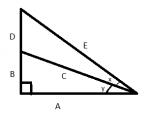syncmaster913n
New member
- Joined
- Dec 11, 2016
- Messages
- 22
Hello,
I am trying to prove to myself, for fun/learning, the sine angle addition identity. Disregarding whether my approach is correct or not, I'm getting a strange algebraic result near the end that I am finding hard to explain. So I came up with this drawing:

And I want to prove that:

I did the following:

I wanted to get rid of the C from the denominator of the first term, so I divided the numerator and denominator by C:

Keeping in mind that (from the triangles image above):

What I wanted to do now is prove that:

The only way for this equation to hold however would be for this to be true:

And for this in turn to be true, a/c must equal 1, which clearly cannot be the case.
I'm guessing the mistake is trivial and right under my nose. Would someone be kind enough to point it out?
I am trying to prove to myself, for fun/learning, the sine angle addition identity. Disregarding whether my approach is correct or not, I'm getting a strange algebraic result near the end that I am finding hard to explain. So I came up with this drawing:
And I want to prove that:
I did the following:
I wanted to get rid of the C from the denominator of the first term, so I divided the numerator and denominator by C:
Keeping in mind that (from the triangles image above):
What I wanted to do now is prove that:
The only way for this equation to hold however would be for this to be true:
And for this in turn to be true, a/c must equal 1, which clearly cannot be the case.
I'm guessing the mistake is trivial and right under my nose. Would someone be kind enough to point it out?


